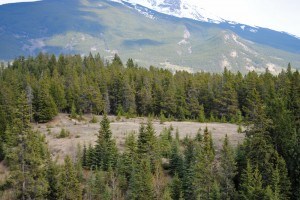
Living in a national park it can be easy to forget that people have a lasting impact on the environment, even decades down the road.
Those impacts are especially stark when you consider there are approximately 40 contaminated sites in Jasper National Park.
While the majority of these sites pose a minimal risk to human health and the environment—if any risk at all—more than a dozen sites are flagged by Parks Canada for possible contamination.
Greg Fenton, Jasper’s field unit superintendent, said seven sites are being actively monitored and could be prioritized for remediation, while another 12 sites need to be further assessed.
“Parks Canada is committed to ensuring the safety of people, facilities and surrounding lands. There are no significant environmental impacts or safety concerns with the sites identified in Jasper National Park,” he stated in an emailed statement.
Sites such as the Maligne Lake dump, and the town’s former dump and incinerator—located along Cottonwood Creek at the east end of town—are considered active and are currently being monitored, according to the Federal Contaminated Sites Inventory.
In Jasper, there are six contaminated sites in town and 14 more within the municipality, according to a report recently tabled at a municipal council meeting.
These sites include diesel spills, discharges of oil and grease into storm drains and historic underground heating oil tanks.
Sites outside of the municipality include fuel storage facilities at the Sunwapta Warden Station and the Tangle Creek highway maintenance compound, among others.
“We recognize this is a historic issue and that some of these issues were caused at a time when people didn’t have as good an understanding about what they were doing,” said Alison Ronson, executive director for the Canadian Parks and Wilderness Society.
“We’re very encouraged that Parks Canada is working to clean up contaminated sites within the park. We know it takes time and we’re happy funding has been devoted to activities like this.”
According to the federal government, a site is considered contaminated when there is a high concentration of any physical, chemical, biological or radiological substance that exceeds a normal level, and poses an immediate or long-term hazard to human health and the environment.
Although brief in detail, the federal inventory identifies each site’s precise location, the contaminant, the site management strategy, and how much money has been spent to remediate or monitor the site.
For example, ground water at the old dump and incinerator is contaminated and currently being monitored. Parks has spent nearly $60,000 to assess and monitor the site and it is currently developing a remediation and risk management plan.
To date, Parks has completely rehabilitated three sites in Jasper and determined 18 others pose a minimal risk, or no risk at all, to human health and the environment.
“Much of the work is focused on dealing with the cleanup of historic issues caused by normal operations at a time when environmental impacts were not as well understood as today,” wrote Fenton.
For example, in 2009 Parks closed the landfill at the transfer station—it now trucks commercial waste to a facility outside the park.
A year later, the agency removed a heating oil tank at the Brewster Chalet at Maligne Lake.
In comparison, there are approximately 48 sites in Banff National Park, such as Ya Ha Tinda Ranch, the Forty Mile Creek landfill and the Anthracite mine site.
In Banff, Parks has remediated three sites and determined that 22 don’t require any further attention.
Across the country there are about 21,000 federal sites listed on the national inventory.
Over the past 10 years, Parks has invested over $2.8 million in remediating sites in Jasper National Park, as part of the Federal Contaminated Sites Action Plan.
Established in 2005, the government initially committed $4.33 billion over 15 years to mitigate the risks of contaminated sites across the country.
In 2012, the government renewed its commitment and invested another $1 billion over three years.
For the 2015-16 fiscal year, the government estimates it will spend $233 million, according to Mélanie Quesnel, a media relations advisor for Environment Canada.
She said agencies and departments are expected to spend an additional $23 million this year as part of the program’s cost-sharing provisions.
In the most recent budget, the government committed another $99.6 million over four years, starting in 2016-17.
Next year, municipalities across the country, including Jasper, will be required by law to account and report liabilities associated with the remediation of contaminated sites in town.
Paul Clarke
Special to the Fitzhugh
